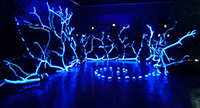Alsos*, meaning ‘sacred wood’ in Greek, is an installation of a recreated imaginary forest which allows the audience to interact with it. This is the Computer Art Image of the Month for August 2011.
Currently on view it is the first London show by the French art duo Scenocosme - Grégory Lasserre and Anaïs met den Ancxt. They have been exploring ‘energetic relationships between living beings and their environment’ in their art for the last few years, says Ancxt, and ‘allowing viewers to become actors.’
Scenocosme creates hybrids between plants and digital technology. Plants are natural sensors and are sensitive to various energy flows. The artists use digital technologies to establish a relationship between plants and sound and enable audience gestures and movements to generate sound effects and changes in their interactive environments resulting in a random musical universe.
With Alsos*, Scenocosme invites the audience to be in the centre of musical or choreographic collective performance at the heart of which is a forest, they say, representing ‘an ambivalent and mysterious place. Quiet, secret, deep, the forest is a place of strange meetings, of evil spells and enchantments. A closed space, it brings back man to his origins, roots. This space invites the audience in to daydream about a fantastic universe.’
The viewer enters the darkened gallery guided by a luminous stony path as though participating in a fairytale, but instead of a picnic for grandma or breadcrumbs, we are given torches. This lights our way but more importantly it allows us to see fluorescently-coloured artificial flowers hidden amongst the mass of branches, leaves and twigs. A feeling of both the magical and mysterious is created.
To a background sound of forest noises - birdsong and so on, we soon discover that by shining our torch at these flowers we too can contribute to the melodic noise. The flowers are equipped with light sensors which react to luminous modifications by emitting distinct sounds transmitted to a data-processing program. A concealed computer analyses the data and plays the melody generated with the movements of the lights.
Thus is created what the artists call ‘a complex acousmatic universe’, turning the spectators into ‘apprentice musicians’. Each flower has its own sonority which is played according to the light intensity - one sounded like a pleasing peel of bells. It is tempting to create one’s own compositions by flashing the torch around ‘hitting’ different flowers or, if there are other visitors present, to engage in a glorious cooperative cacophony, which due to its participatory nature always varies.
The artists state that they use technology but wish to hide it to give the illusion of ‘living’ artwork and they believe that the randomness inherent in the piece makes it seem more alive. Also on view in the same venue is another work called Akousmaflore, which perhaps demonstrates their ambition more completely in that it uses real, living plants. This is a musical plants piece in which sound is generated when the viewer touches growing ivy hanging from the ceiling in baskets. Our invisible electrical aura acts on the plants and a plant concert ensues.
This reminds me of an early work by John Lifton, a British pioneer in the area of cybernetics and synaesthetic environments. His Green Music, an electronic system for the production of music from the internal processes of plants was exhibited at Interact, a Computer Arts Society exhibition way back in 1973. Small, electrical signals within a group of plants were measured by electrodes and after processing by an analogue computing and storage system, were fed into a sound synthesiser and an electronic music analogy produced.
By contrasting the relationship between the natural world (represented here by the forest and ivy) and the man-made (the digital), Scenocosme’s art highlights the challenges facing our planet and our human responses to it. The late artist Mark Boyle wrote, ‘The most complete change an individual can effect in his environment, short of destroying it, is to change his attitude to it.’ (Quoted in Control Magazine, 1965). I can’t help thinking that digital art - uniquely placed with its participatory and interactive abilities, has a strong role to play in offering interpretations of how we may live in synergy with our environment.
The Scenocosme exhibition runs until Friday 30 September 2011 at Watermans, Brentford, London (recently named West London’s leading gallery for new media art), supported by the Institut Français.
Catherine Mason is the author of A Computer in the Art Room: the origins of British computer arts 1950-80, published in 2008.
More information on the Computer Arts Society, including our events programme
Alsos* by Scenocosme, 2011
Mixed media
Copyright the artists, reproduced with permission













